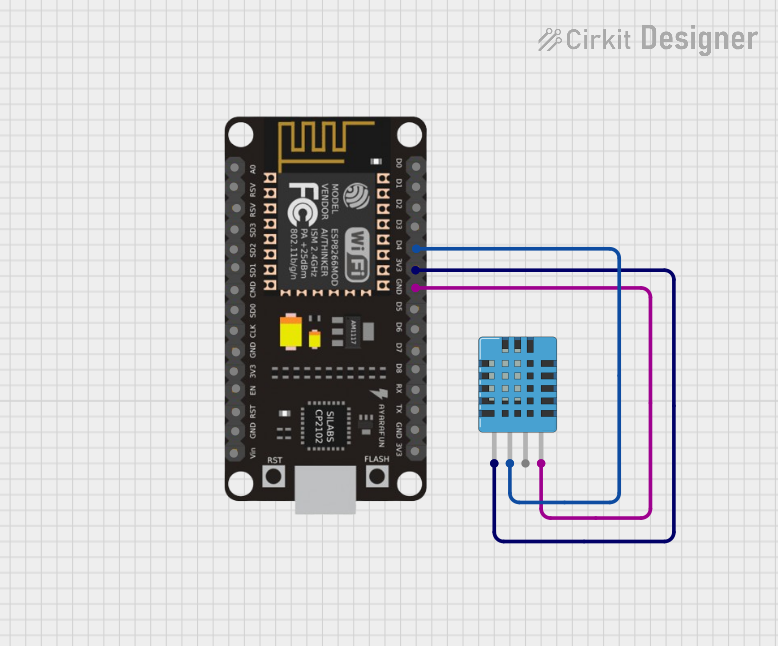
ESP8266 NodeMCU with DHT11 Sensor for Temperature and Humidity Monitoring

Circuit Documentation
Summary of the Circuit
This circuit integrates an ESP8266 NodeMCU microcontroller with a DHT11 Humidity and Temperature Sensor. The ESP8266 NodeMCU is a Wi-Fi capable microcontroller that can be programmed to read data from various sensors and perform actions over the internet. The DHT11 sensor is used to measure the ambient temperature and humidity. The data lines of the DHT11 sensor are connected to the ESP8266 NodeMCU, allowing the microcontroller to read the sensor's output. The sensor is powered by the 3.3V output from the ESP8266 NodeMCU, and both devices share a common ground.
Component List
ESP8266 NodeMCU
- Description: A Wi-Fi capable microcontroller with multiple GPIO pins.
- Pins: D0, D1, D2, D3, D4, 3V3, GND, D5, D6, D7, D8, RX, TX, A0, RSV, SD3, SD2, SD1, CMD, SD0, CLK, EN, RST, VIN
DHT11 Humidity and Temperature Sensor
- Description: A sensor for measuring ambient humidity and temperature.
- Pins: VDD, DATA, NULL, GND
Wiring Details
ESP8266 NodeMCU
- 3V3: Provides power to the DHT11 sensor.
- GND: Connected to the ground pin of the DHT11 sensor to complete the power circuit.
- D4: Acts as the data input pin connected to the DATA pin of the DHT11 sensor.
DHT11 Humidity and Temperature Sensor
- VDD: Receives power from the 3V3 pin of the ESP8266 NodeMCU.
- DATA: Sends data to the D4 pin of the ESP8266 NodeMCU.
- GND: Connected to the ground pin of the ESP8266 NodeMCU to complete the power circuit.
Documented Code
No code has been provided for the microcontroller. To fully utilize the ESP8266 NodeMCU and DHT11 sensor, embedded code is required to initialize the sensor, read data, and process the information. The code would typically be written in C or C++ using an SDK like the Arduino IDE or the native ESP8266 SDK. It would include libraries for Wi-Fi communication and for interfacing with the DHT11 sensor.
Since no code is available, this section cannot be completed. However, if code were provided, it would be documented here with explanations of the functions, logic, and any libraries used.